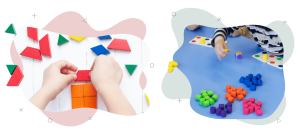35 Assessing learning outcomes: mathematical conversations
Mathematics has developed from our social activity and as a way of making sense of our world. Play-based and inquiry learning in its many forms involves students in mathematical experiences because mathematics is part of their world and everyday lives. This is why mathematics has practical or ‘real life’ applications that play-based and inquiry learning can reveal. It is also where we see students’ numeracy in action, as they draw on their mathematics skills and knowledge and use these purposefully in a range of situations.
Play for mathematics learning develops students’ mathematical ideas through their language use, as the development of mathematical language enables students to reflect on their learning. Student language use, along with observation, is therefore a key indicator for assessing mathematical knowledge and mathematical thinking. An article by Caroline Cohrssen from the ECA Blog ‘The Spoke’ (2018) encourages teachers to think carefully about the role of questions and conversation when assessing play in mathematics.

Assessing mathematics in play
To assess mathematics, teachers have to know what to look for, and what learning can come next, so an understanding of mathematics and mathematical learning trajectories is central to effective assessment. Perry & Dockett (2010) highlight that for teachers to assess students’ mathematical knowledge and understanding in play, they need “…mathematical knowledge; understanding the nature of students’ play, particularly the characteristics of play that promote mathematical learning and thinking and awareness of the role of adults in promoting both play and mathematical understanding” (p. 715). The teacher’s openness to the opportunities play presents for mathematics assessment is also important. Let’s look more closely at these ideas.
We can make students’ learning visible through the actions we take and the data we collect about what students do and create. Teachers need a range of strategies to gain access to students’ current and developing mathematical knowledge and thinking, beginning with what mathematics they notice students engaging with in their play and inquiry.
How do teacher’s assess mathematics outcomes?
Mathematical ideas shared during meaningful conversations
Teachers can see students playing with mathematics even when they are not playing with objects. Mathematical ideas lend themselves to play. Teachers can observe in the conversations that takes place between each other and teacher and student.
Move the slider to read the interactions between teachers and children. As you move through the examples, consider how do teacher interactions support students’ mathematical thinking.
Ways of assessing mathematics
Although free play provides opportunities for mathematics learning, play that best supports mathematics learning, includes scaffolded dramatic and make-believe play (Clements, Sarama, Layzer, Unlu & Fesler, 2020), and is characterised as guided, where students experience choice and control in their play while the teacher brings the mathematics in the play into focus. In this role, the teacher uses questioning and discussion to guide explicit and extended exploration of the mathematics the students are engaging with and supports them to make connections between the mathematics and their play (Lee & Ginsburg, 2009).

